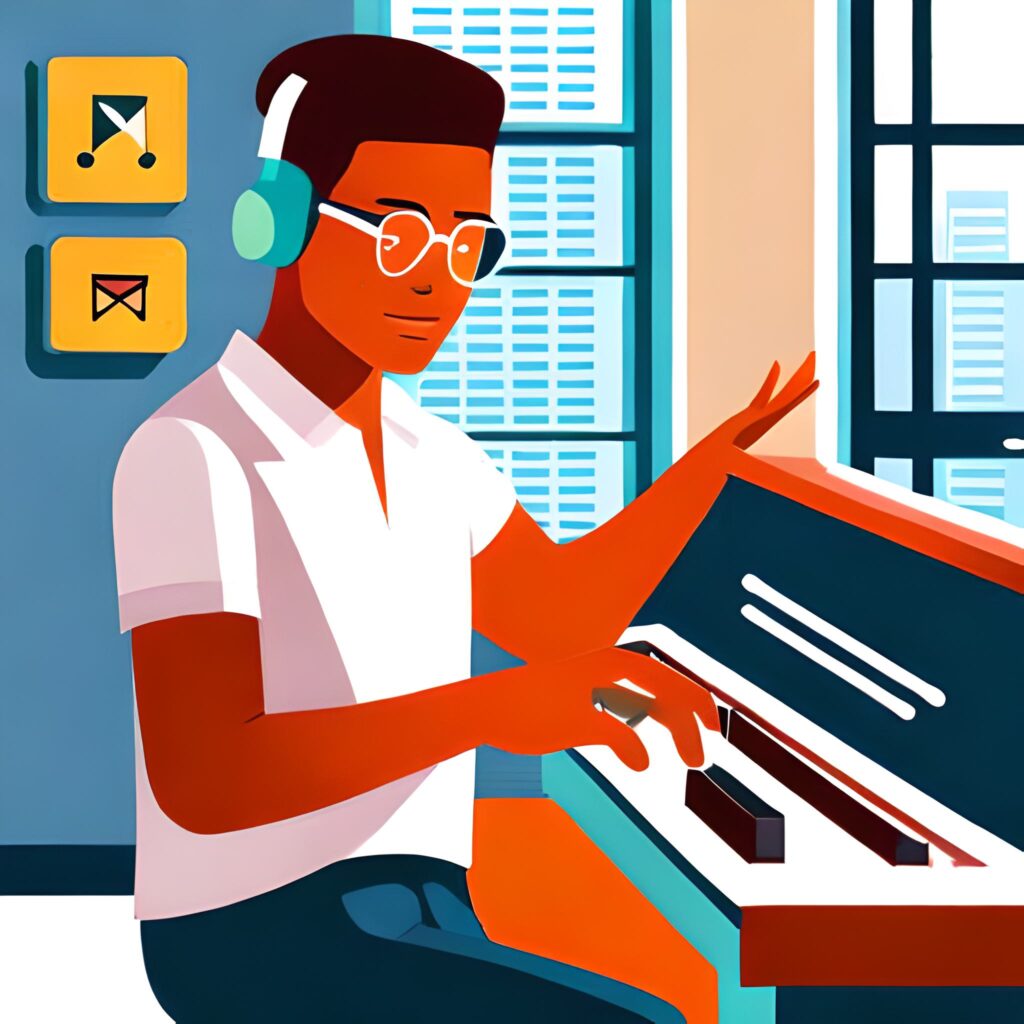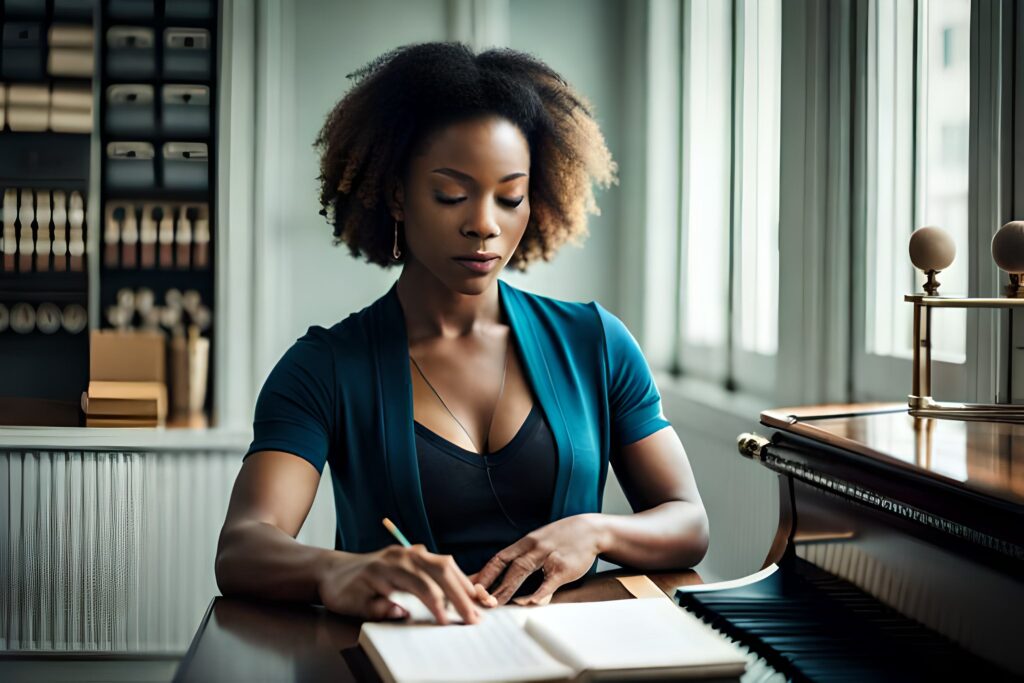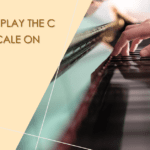Learning piano can be a dream for many, but not everyone has the resources to purchase or access a physical instrument. However, that shouldn’t stop anyone from pursuing their passion for music.
In fact, there are several benefits to learning piano without a piano. Firstly, learning the basics of music theory and practising finger placement can easily be achieved without an actual keyboard.

You can use diagrams or just your fingers on a table to visualize where notes would be on keys. This approach allows you to focus solely on technique and understanding the notes before incorporating the physical act of pressing keys.
Another benefit is the utilization of technology in modern times. With various apps and software available, there are several options for practising piano without needing a physical instrument.
These applications provide interactive lessons and feedback that can help improve your skills at no extra cost. Mental practice is an often-overlooked yet extremely powerful tool in improving piano skills.
Without an actual keyboard present, it requires more imagination and visualization of playing keys in your head. This form of practice helps in developing muscle memory as well as enhancing creativity by allowing you to experiment with different melodies and chords mentally.
| Key Takeaways |
|---|
| 1. Learning piano without a physical instrument can be cost-efficient and convenient. |
| 2. Utilize technology, such as piano apps and software, for interactive lessons and feedback. |
| 3. Practice improvisation techniques to develop creativity and musical understanding. |
| 4. Mental practice, visualization, and mindfulness can improve muscle memory and reduce anxiety. |
| 5. Learning a piano without a physical instrument can be cost-efficient and convenient. |
| 6. Avoid common mistakes such as neglecting music theory, inconsistent practice, and not seeking feedback. |
| 7. Stay committed, remain creative, and practice regularly to unlock your inner pianist. |
The Benefits Of Learning Piano Without A Physical Instrument
While some may argue that learning without access to an actual instrument is pointless or limiting in some way, I strongly believe otherwise. The benefits of taking this unconventional approach are numerous and should not be underestimated.

One major advantage is cost-efficiency; buying or renting keyboards can be expensive, especially if you’re not entirely sure if playing the piano will become one of your long-term hobbies.
Learning without purchasing any equipment means you won’t have to worry about wasting money if it doesn’t work out for you. Another benefit is convenience; removing the need for an instrument eliminates geographical barriers preventing people from pursuing their interests due to a lack of access to physical resources.
With modern technology, it’s now possible to learn the basics of piano from almost anywhere in the world. Moreover, learning this way makes you more creative and resourceful.
You have to think outside the box and find new ways of practising that don’t necessarily involve a keyboard. This approach helps develop problem-solving skills as well as musical creativity.
Setting The Tone For A Creative Guide
Now that we’ve covered the benefits of learning piano without a piano, it’s time to get excited about the possibilities. This guide will provide you with various approaches and tools for improving your piano skills without needing a physical instrument.

Whether you’re an absolute beginner or an experienced pianist looking for new methods to practice, this guide has something for everyone. It’s important to keep an open mind and see this unconventional approach as an opportunity rather than a limitation.
By embracing creativity and utilizing technology, you’ll discover new ways of learning that improve your piano skills and enhance your overall musicality. So grab a notebook, your favourite device, and let’s dive into the fascinating world of learning how to play piano without a physical instrument!
Utilizing Technology: The New Age Way to Practice
While traditional methods of learning music theory and piano have been around for centuries, times have changed. With technology advancing at an unprecedented pace, it’s only natural that we utilize it in our quest to learn the piano without an actual piano.
Thankfully, there are a plethora of apps and software available that can help us achieve this goal. One popular app is Simply Piano, which uses interactive lessons and challenges to teach users how to play the piano.
The app listens to the user play via the microphone on their device and provides immediate feedback. Another great option is Yousician, which offers video tutorials as well as gamified practice sessions to keep users engaged while they learn.
And if you prefer a more traditional approach but still need a digital alternative, Piano Marvel provides sheet music and exercises that can be practised on your computer or tablet.
These apps provide endless opportunities for practising without a physical instrument and offer features like progress tracking and personalized lesson plans based on your skill level.
Plus, many of these apps are affordable or even free to use! So why not take advantage of these resources and make the most out of your practice time?
Improvisation Techniques: Thinking Outside the Box
Who said learning piano had to be boring? While understanding basic music theory is important for building a strong foundation in piano playing, sometimes mixing things up with improvisation techniques is fun.

One technique is rhythmic improvisation – clapping or tapping exercises to improve timing and groove while teaching hand independence.
Melodic improvisation involves creating original melodies by ear or using familiar scales as a starting point. And lastly, harmonic improvisation involves experimenting with chord progressions and accompaniment styles.
By incorporating improvisation into your practice routine, not only will you keep things interesting but you’ll also develop a deeper understanding of musical structure and composition. You might even discover some unique techniques or styles you wouldn’t have found otherwise.
Mental Practice: The Power of Mind Over Matter
Believe it or not, mental practice can be just as effective as physical practice when it comes to learning the piano. Visualization and mental rehearsal are powerful tools that can help improve muscle memory, increase motivation, and reduce anxiety.
To begin, find a quiet space where you won’t be interrupted and close your eyes. Imagine yourself sitting at a piano, feeling the keys under your fingers as you play notes and scales.

Visualize the movements of your fingers and hands with as much detail as possible. You can also try imagining yourself playing your favourite song or performing in front of an audience.
Incorporating mindfulness or meditation practices into your mental practice routine can also help reduce stress and improve focus.
By taking this time to visualize yourself playing piano without an actual piano, you’ll be able to reinforce muscle memory while giving your mind a break from the physical exertion of practising on an instrument.
The Art of Improvisation Without a Piano
Finding Harmony in Everyday Objects
Learning to improvise is one of the most valuable skills a pianist can have. It allows you to become more creative, expressive, and versatile in your playing.
But what if you don’t have access to a physical piano to practice on? Improvisation without a piano is possible and can be just as effective with the right approach.
One technique for practising improvisation without a piano is to use everyday objects like pencils or cups. These objects can be used as substitutes for piano keys and provide an opportunity to work on finger placement and coordination.

Simply tapping your fingers on different surfaces can help develop your sense of rhythm and timing, while playing around with various sounds that different objects make can help create new melodies in your head. Another great way to improve improvisation skills without a physical instrument is by focusing on harmony.
One exercise is humming or singing different notes while trying to hear how they harmonize together. This develops an awareness of how different notes sound when played together, making it easier for you to recognize chords and progressions when playing actual songs on the piano.
Mastering Melodies Without Keys
Melody is an important aspect of any musical composition, but how do you work on improving it without access to a piano? One technique is using your voice or instruments like guitar or ukulele as substitutes for the keyboard.
By singing or playing melodies on these instruments, you develop an understanding of pitch, tone, and phrasing that can be translated back into your piano playing later. Another way of working specifically with melody when practising improvisation without a physical instrument involves listening closely to music in everyday life.
Pay attention to the melodies in your favourite songs or background music in films and TV shows. Try to analyze what makes those melodies catchy and memorable, then focus on creating your own melodies by using similar techniques.
Once you have a melody in mind, try singing or humming it while tapping out the rhythm on a table or other surface. This helps develop your sense of timing and coordination, allowing you to play any melody more effectively when you do get access to a piano.
Rhythm Practice Without A Piano
While rhythm is often seen as intuitive for some, it can be difficult to master without practice. Fortunately, improvisation without a physical instrument allows for plenty of rhythmic practice opportunities.
One exercise involves using everyday objects like pencils or cups (as previously mentioned) as substitutes for drumsticks.
Creating different rhythms with these objects helps develop dexterity and precision with your fingers while also honing in on timing skills.
An alternative method is listening closely to music you enjoy at a lower volume and trying to tap along to the beat with your fingers or feet – doing so allows you to both improve your sense of rhythm and appreciation towards various styles of music as well!
common mistakes to avoid when learning piano without a physical instrument
Here are some common mistakes to avoid when learning piano without a physical instrument:
- Not focusing on finger technique: Without a physical piano, it’s easy to overlook the importance of proper finger positioning and technique. Use a virtual piano or MIDI keyboard to practice correct finger placement and movements.
- Skipping music theory: Music theory is essential for correctly understanding how to play piano. Don’t neglect to learn the basics of notes, rhythms, scales, and chords; this knowledge will help you play more effectively.
- Inconsistent practice: Regular practice is crucial to making progress. Set aside time each day to practice, and stick to a consistent schedule to develop good habits and improve your skills.
- Ignoring dynamics and articulation: Without the tactile feedback of a physical piano, it’s easy to overlook dynamics (how loudly or softly to play) and articulation (how notes are connected or separated). Pay attention to these aspects of your playing and practice applying them in your virtual piano or MIDI keyboard sessions.
- Relying solely on muscle memory: Playing without a physical instrument can lead to an overreliance on muscle memory, which may make it difficult to adapt to a real piano later. Be mindful of your technique and focus on understanding the music rather than just memorizing finger movements.
- Not seeking feedback: It’s essential to get feedback on your playing to identify areas for improvement. Share your progress with a friend, family member, or online community, or consider investing in a few lessons with a piano teacher.
- Rushing through pieces: Resist the temptation to play through pieces too quickly. Take your time to learn the notes, dynamics, and proper fingerings, and gradually increase the tempo as you become more comfortable.
By being aware of these common mistakes and taking steps to avoid them, you’ll be better positioned to learn piano effectively, even without a physical instrument.
Mental Practice: Unlocking Your Inner Pianist
The Power of Mental Practice
Many aspiring pianists dream of playing beautiful music effortlessly without hitting the wrong note. While this may seem like an unattainable goal, mental practice can help you achieve it.

By visualizing yourself playing on a keyboard or imagining finger movements on keys, you can train your brain to think and act like a real pianist. Research has shown that mental practice can improve your skills just as much as physical practice.
In fact, Olympic athletes have been using this technique for decades to enhance their performance. And just like an athlete, a musician must also train their mind in order to excel.
Visualizing Your Success
One effective technique for mental practice is visualization. Close your eyes and imagine yourself sitting in front of a keyboard with perfect posture and hand placement.
Then visualize yourself smoothly playing through scales and melodies, hitting every note with precision. Take it even further by imagining yourself performing in front of an audience or recording in a studio.
Visualize the feeling of accomplishment and the sound of applause ringing through the air. This will improve your piano skills and boost your confidence when playing in front of others.
Meditation and Mindfulness
Incorporating meditation or mindfulness practices into your mental practice routine can also be beneficial for improving piano skills.
These practices help you develop focus, concentration, and relaxation techniques that are essential for performing at your best. Start by finding a quiet place where you won’t be interrupted for at least 10-15 minutes.

Sit comfortably with good posture and begin by taking deep breaths while clearing your mind of any distractions or worries. Next, focus on visualizing yourself playing the piano easily while remaining calm and relaxed throughout the process.
Repeat positive affirmations to yourself, such as “I am capable of playing beautiful music” or “I am confident in my abilities.” You will significantly improve your piano skills and overall well-being with time and practice.
Mental practice is a powerful tool that can help you improve your piano skills without the need for a physical instrument.
By incorporating visualization techniques, meditation, and mindfulness practices into your routine, you can train your mind to think like a real pianist and achieve the desired level of success. So go ahead and unlock your inner pianist today!
Conclusion
Moving Forward
Learning to play the piano can be a long and difficult journey, but it is also incredibly rewarding. The key is to remember that you don’t need a physical instrument to get started. With the resources and techniques discussed in this guide, you can start building your skills and hone your craft immediately.
The Power of Practice
Whether you’re using an app, practising mental visualization, or simply tapping along on a desk with your fingers, every moment of practice counts. The key is to remain committed and dedicated to improving your skills over time. Remember that even the most accomplished pianists started somewhere.
- You Might Also Like: How Long to Master Piano?
The Importance of Creativity
It’s important to remember that learning piano without a piano can actually be an incredibly creative and empowering experience.
By using your imagination and finding new ways to express yourself through music, you may discover endless possibilities for what you can accomplish with just a little determination and dedication.
We urge readers not be discouraged by their current situation or lack of access to a physical instrument – anyone can learn how to play the piano if they truly believe in themselves and continually strive for improvement.
With these tips and techniques at their disposal, budding pianists worldwide can unlock their inner creativity while honing their musical abilities – all without touching a physical keyboard!
So, dare to dream big, stay committed, keep practising…and who knows? You might surprise yourself with what you’re capable of achieving!




